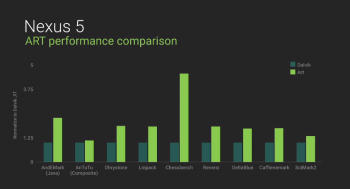
Android ‘L’ migrates to ART runtime, abandons Dalvik
As Google previews their next Android release (so far only referred to as ‘L’), we are beginning to learn more not only about a new design approach but also the new runtime that will offer performance beyond what we have seen before from the platform. Long relying on Dalvik as its backbone, Android L abandons the standard in order to migrate to ART, a cross-platform runtime that supports ARM, X86, and MIPS simultaneously.
The main difference between ART and Dalvik rests in how the runtimes handle the execution of applications. Dalvik used a JIT (just-in-time) compiler that only ran code as it was needed. ART relies on an AOT (ahead-of-time) compiler to process code in advance, resulting in a much smoother performance curve. ART has been in place since the launch of Android 4.4 as an option alongside Dalvik, but with this ‘L’ release it will become the standard.
ART is not only faster, but it also offers improvements in battery life thanks to more efficient processing. The best part is that the tun rime is immediately compatible with the existing Android ecosystem and its apps. Developers won’t need to do anything special to bring their apps and games in line with this latest runtime, but all will be able to benefit from the results.